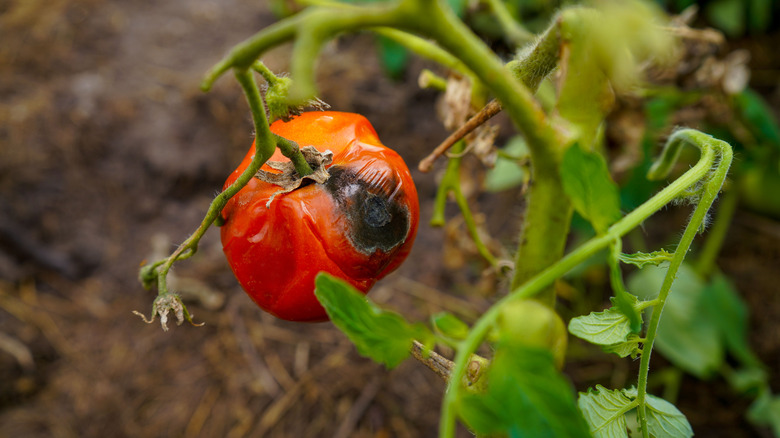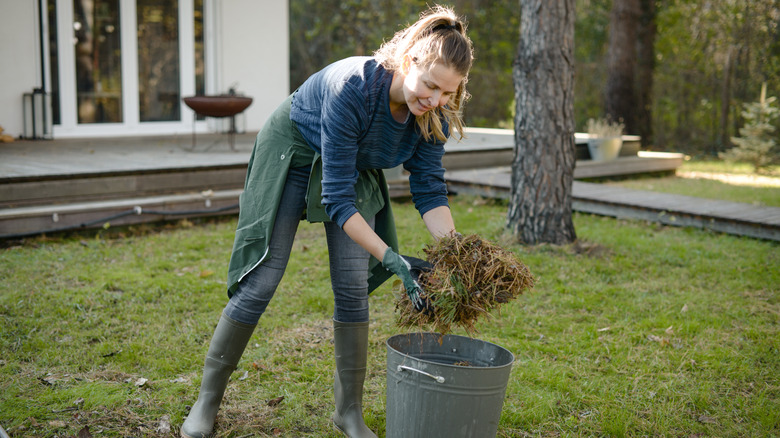What You Need To Know Before Adding Diseased Plants To Your Compost Pile
Gardeners should exercise caution when considering whether to compost diseased plants, as not all plant diseases are effectively eradicated during the composting process, and using infected compost can lead to future garden problems. While composting offers many benefits, including recycling organic materials and creating nutrient-rich soil amendments, it may not always kill or neutralize certain pathogens.
Several factors contribute to the persistence of diseases in compost. First, some pathogens are highly resilient and can survive the composting process. Second, the microbial balance in the compost heap can be disrupted, favoring the survival of certain pathogens. This has become especially true with climate change as certain areas of the globe experience altered weather patterns. Furthermore, spores and resistant structures of some fungi and bacteria can withstand the decomposition process.
When gardeners use compost containing undecomposed diseased plant material or viable pathogens, they risk reintroducing these diseases to their gardens. This can lead to poor plant health, reduced yields, and the need for pesticides or other control measures. Common garden diseases, like powdery mildew, tomato blight, or clubroot, can persist in compost and infect new plantings when applied.
To mitigate these risks, gardeners should employ a "hot composting" technique and ensure their compost piles reach the appropriate temperatures (140-155°F or 60-68°C) and maintain those temperatures for a sustained period to kill pathogens. Additionally, practicing good composting methods, including thorough mixing and proper turning, can help break down plant material effectively.
Diseased plants you should avoid composting
Several types of diseased plants should never be composted due to the risks they pose to future gardens. Plants affected by tomato blight should not be composted. This pathogen can produce highly resilient spores that often survive even rigorous composting processes. If infected tomato plants are composted, the compost may carry these spores and infect new tomato plants. Gardeners might observe rapid wilting, browning of leaves, and overall plant decline, potentially leading to crop loss.
Clubroot is another common disease affecting cabbage and other Brassica family plants. It is caused by a soil-borne pathogen. Infected plant material should not be added to compost, as the pathogen can persist and contaminate the soil once the compost is applied. In future gardens, this can result in stunted growth, malformed roots, and reduced yields of Brassica crops like broccoli, cauliflower, and turnips.
Roses plagued by black spot, a fungal disease, should also be avoided in compost piles. The disease produces durable spores that may not be completely eradicated through composting. Compost containing these spores can reintroduce black spot to rose beds, causing unsightly black lesions on leaves, leaf drop, and reduced bloom quality.
Late blight is a notorious pathogen responsible for the Irish Potato Famine. Plants infected with late blight should not be composted, as the spores are incredibly resilient. Compost containing late blight-infected plant material can transmit the disease to future potato crops, leading to decay, rotting, and severe crop loss.
How to properly dispose of diseased plants
When cleaning up your garden at the end of the season, take care to properly dispose of diseased plants to prevent contamination and infection of future gardens. To ensure the safe disposal of plants afflicted by diseases that should not be placed in a compost pile, first, correctly identify the diseased plants in your garden. Make sure you are dealing with pathogens like tomato blight, clubroot, black spot, or late blight, as previously mentioned.
Carefully remove and segregate the diseased plant material. Use clean, sharp tools to minimize the spread of pathogens and clean them after. Place the infected plant parts in a dedicated container or bag, separate from healthy garden waste. Seal the container or bag to prevent any pathogens from escaping. Clearly label it as "Diseased Plant Material" to avoid confusion.
Burning the material can destroy pathogens, but in many areas, open burning is restricted or prohibited due to environmental concerns. One of the safest ways to dispose of diseased plants is to place them in your regular municipal waste collection. This ensures that the material is managed and processed in a way that minimizes the risk of contaminating future garden soil.
In some cases, especially with large or severe infestations, it may be advisable to hire professional removal and disposal services. They can handle the material safely and in compliance with local regulations. Do not reuse the containers or bags used for diseased plant disposal to prevent potential contamination.


